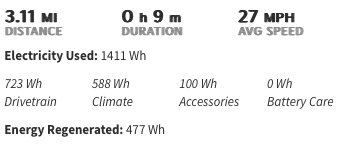(Almost) A Year of EV Driving Data
In March we purchased a (used) 2022 Kia EV6. We have the rear-wheel-drive model, which means better range/efficiency but no heat pump: in the winter it uses a electricity-hungry resistive heater.
I love the car. I love all the modern car features (our other car is a 2012), cameras, adaptive cruise control, etc. Though you could get those features on any car. The instant torque and responsive acceleration of an EV is my favorite thing about it. No downshifting on the highway, no noise when I need to accelerate quickly, it just quietly zips along. It’s fun, even the RWD model.
Getting the Data
Let’s talk data. The Kia Owners Portal has a poorly named Locations section which can show recent drives/trips. For me, a trip shows up as a little HTML Cards like this:

That’s a pretty good set of information. I was excited to see an “Export” button with an option for export to Excel. Alas, the “export” feature on the Kia Portal omits all the useful data in the screenshot. Instead it has the start and end time of the trip, the total miles driven, and that’s about it. Useless!
But I knew the data must be there somewhere on the web site, and it was relatively easy to use Safari’s web inspector to find a hidden REST API that returns nice structured JSON that contained all the data used to make that HTML card and more. (Though, the API is so slow I wonder if it’s phoning home to the car?) The data includes:
evPowerConsumption_climateSystemevPowerConsumption_driveTrainevPowerConsumption_mileage(in miles per watt)evPowerConsumption_regenerated(broken out, but already subtracted from total power below)evPowerConsumption_totalPower
You might see the screenshot and think, “Wow, 3.11 miles, such precise distance information!” Alas, no. Kia appears to store their distance information internally in integer kilometers, then converts those to miles for delivery via the API. 3.11 miles is 5 km. There’s no data point with 3.23 miles, for example. So the resolution on the distances for the short drives isn’t great. I’ve excluded very short drives from much of this analysis.
Plots
Efficiency by week
We purchased an EV6 in March, and below is aggregated weekly data for 2023. I’m still not sure what was happening that week in October. We did a modest road trip that week, and apparently the highway drives were incredibly efficient. Yet, the climate usage wasn’t any lower than similarly long trips in May. I can’t quite explain it. I believe these drives were done in “Eco” mode, but it is still a surprisingly high number. Otherwise the data correlates with climate system usage, and trends lower into the winter months.
Miles Driven
Monthly Energy Usage
Energy Efficiency by Time of Day
It’s not surprising that the use of climate control in the car has the biggest impact on efficiency. In addition to seeing the trend over the year, it can also be seen in efficiency binned by time of day.
In the summer, morning drives were more efficient with the least efficient hours being the hottest parts of the afternoon. Although, the difference in the afternoon hours vs the morning hours is fairly small. There were a small number of very efficient late evening drives as well.
In the winter, the morning drives were the least efficient: the car was cold and the heater used lot of energy expended to warm it up. Plus, 8AM drives are usually short, cold drives to work or school. I would be curious to see similar data for the AWD model (with a heat pump).
May 29 to September 4
October 15 to December 31
Cost and Summary
I can see how much energy I used all year and, multiplying by a typical utility rate see how much I spent charging the car. I can also then take the miles driven, assuming a pretty generous 35 MPG (based on our hybrid Camry) and see what those miles would cost at $3.30 a gallon. (I think that’s about the average this year? I can’t find average gas price by month…just the current price which is closer to $3/gallon.)
- Total energy used by the car this year: 2160 kWh
- Total Miles driven: 8639
- Cost of electricity: $274*
- Equivalent gas cost for same mileage would be $814.
Our savings versus gas aren’t quite as big as above. On our long trips we have to charge at DC fast chargers and pay 30-40 cents per kWh. On a few trips we were able to get some kWh at “free” chargers (free at least when paying for parking). Still, I’d probably add at least $100 of fast charging costs to account for our trip charging.
The savings over gas (and I guess not paying for oil changes) is nice, but is not close to offseting the current cost premium EVs have over gasoline cars (nor Virginia’s vehicle property tax). The time savings of never going to a gas station is more noticeable than the dollars saved over gasoline.
My total efficiency for 2023 was 4.00 miles/kwh. This number is certainly helped by not having the car yet in January and February. It is equivalent to 307.85 miles of range, which is essentially what Kia advertises for the car.